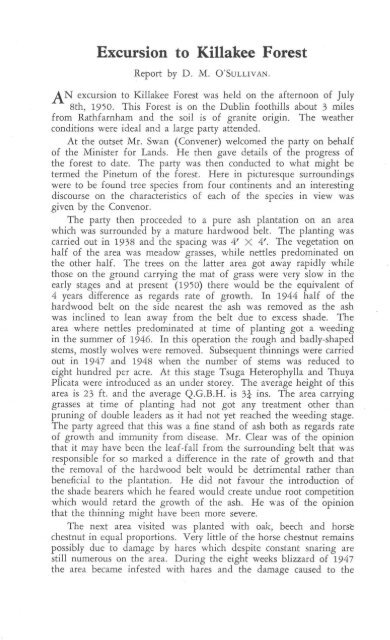Download Full PDF - 17.54 MB - The Society of Irish Foresters
Download Full PDF - 17.54 MB - The Society of Irish Foresters
Download Full PDF - 17.54 MB - The Society of Irish Foresters
You also want an ePaper? Increase the reach of your titles
YUMPU automatically turns print PDFs into web optimized ePapers that Google loves.
Excursion to Killakee Forest<br />
Report by D. M. O·SULLIVAN.<br />
AN excursion to Killakee Forest was held on the afternoon <strong>of</strong> July<br />
8th, 1950. This Forest is on the Dublin foothills about 3 miles<br />
from Rathfarnham and the soil is <strong>of</strong> granite origin. <strong>The</strong> weather<br />
conditions were ideal and a large party attended.<br />
At the outset Mr. Swan (Convener) welcomed the party on behalf<br />
<strong>of</strong> the Minister for Lands. He then gave details <strong>of</strong> the progress <strong>of</strong><br />
the forest to date. <strong>The</strong> party was then conducted to what might be<br />
termed the Pinetum <strong>of</strong> the forest. Here in picturesque surroundings<br />
were to be found tree species from four continents and an interesting<br />
discourse on the characteristics <strong>of</strong> each <strong>of</strong> the species in view was<br />
given by the Convenor.<br />
<strong>The</strong> party then proceeded to a pure ash plantation on an area<br />
which was surrounded by a mature hardwood belt. <strong>The</strong> planting was<br />
carried out in 1938 and the spacing was 4' X 4'. <strong>The</strong> vegetation on<br />
half <strong>of</strong> the area was meadow grasses, while nettles predominated on<br />
the other half. <strong>The</strong> trees on the latter area got away rapidly while<br />
those on the ground carrying the mat <strong>of</strong> grass were very slow in the<br />
early stages and at present (1950) there would be the equivalent <strong>of</strong><br />
4 years difference as regards rate <strong>of</strong> growth. In 1944 half <strong>of</strong> the<br />
hardwood belt on the side nearest the ash was removed as the ash<br />
was inclined to lean away from the belt due to excess shade. <strong>The</strong><br />
area where nettles predominated at time <strong>of</strong> planting got a weeding<br />
in the summer <strong>of</strong> 1946. In this operation the rough and badly-shaped<br />
stems, mostly wolves were removed . Subsequent thinnings were carried<br />
out in 1947 and 1948 when the number <strong>of</strong> stems was reduced to<br />
eight hundred per acre. At this stage Tsuga Heterophylla and Thuya<br />
Plicata were introduced as an under storey. <strong>The</strong> average height <strong>of</strong> this<br />
area is 23 ft. and the average Q.G.B.H. is 3i ins. <strong>The</strong> area carrying<br />
grasses at time <strong>of</strong> planting had not got any treatment other than<br />
pruning <strong>of</strong> double leaders as it had not yet reached the weeding stage.<br />
<strong>The</strong> party agreed that this was a fine stand <strong>of</strong> ash both as regards rate<br />
<strong>of</strong> growth and immunity from disease. Mr. Clear was <strong>of</strong> the opinion<br />
that it may have been the leaf-fall from the surrounding belt that was<br />
responsible for so marked a difference in the rate <strong>of</strong> growth and that<br />
the removal <strong>of</strong> the hardwood belt would be detrimental rather than<br />
beneficial to the plantation. He did not favour the introduction <strong>of</strong><br />
the shade bearers which he feared would create undue root competition<br />
which would retard the growth <strong>of</strong> the ash. He was <strong>of</strong> the opinion<br />
that the thinning might have been more severe.<br />
<strong>The</strong> next area visited was planted with oak, beech and horse<br />
chestnut in equal proportions. Very little <strong>of</strong> the horse chestnut remains<br />
possibly due to damage by hares which despite constant snaring are<br />
still numerous on the area. During the eight weeks blizzard <strong>of</strong> 1947<br />
the area became infested with hares and the damage caused to the

















